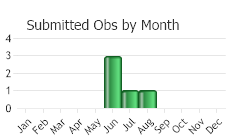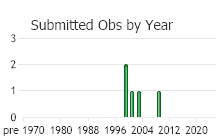View in other NatureServe Network Field Guides
NatureServe
Montana
Utah
Wyoming
Idaho
Wisconsin
British Columbia
South Carolina
Yukon
California
New York
Great-spurred Violet - Viola selkirkii
State Rank Reason (see State Rank above)
Only known in Montana from a few locations in the northwest corner of the state. Additional survey data are needed to document population sizes and extent.
- Details on Status Ranking and Review
Population Size
Score3 - Vey Small: Generally <2,000 individuals.
Commentvery few individuals documented.
Range Extent
Score2 - Regional or State Endemic or Small Montana Range: Generally restricted to an area <100,000 sq. miles (equivalent to 2/3 the size of Montana or less) or Montana contributes 50% or more of the species’ range or populations OR limited to 2-3 Sub-basins in Montana.
Area of Occupancy
Score3 - Very Low: Generally occurring in 3 or fewer Subwatersheds (6th Code HUC’s).
Environmental Specificity
Score1 - Moderate: Species is restricted to a specific habitat that is more widely distributed or to several restricted habitats and is typically dependent upon relatively unaltered, good-quality habitat (C Values of 5-7).
CommentHabitat does not appear to be unique nor especially rare.
Trends
ScoreNA - Rank factor not assessed.
CommentTrends are unknown.
Threats
Score1 - Medium: 11-30% of the populations are being negatively impacted or are likely to be impacted by one or more activities or agents, which are expected to result in decreased populations and/or habitat quality and/or quantity.
CommentNo specific threat or combination of threats appear to be severe in magnitude or immediacy. Timber harvesting, road maintenance and successional dynamics all have the potential to detrimentally impact the species, though none appear to be significant threats at this time.
Intrinsic Vulnerability
Score0-2 - Vulnerability Unknown.
CommentSpecific life history attributes which may limit the species' viability are undocumented.
Raw Conservation Status Score
Score
10 to 12 total points scored out of a possible 16 (Rarity factors and threats only).
General Description
Pubescent without rhizomes or stolons. Stems lacking; peduncles 2–5 cm long. Leaf blades 1–3 cm wide, broadly cordate with crenulate margins, hairy along veins above; stipules lanceolate, glandular-toothed, adnate to the stem. Flowers 8–13 mm long, blue; petals beardless; spur 3–7 mm long; style tip glabrous. Capsule 4–6 mm long (
Lesica et al. 2012. Manual of Montana Vascular Plants. BRIT Press. Fort Worth, TX).
Species Range
Montana Range
Range Descriptions

 Native
Native
Range Comments
Circumboreal south to WA, NM, SD, OH and NH. One collection from Lincoln County (Lesica et al. 2012. Manual of Montana Vascular Plants. BRIT Press. Fort Worth, TX).
Observations in Montana Natural Heritage Program Database
Number of Observations: 5
(Click on the following maps and charts to see full sized version)
Map Help and Descriptions
Relative Density

Recency



 (Observations spanning multiple months or years are excluded from time charts)
(Observations spanning multiple months or years are excluded from time charts)
Habitat
Montane, riparian forests.
National Vegetation Classification System Groups Associated with this Species
Forest and Woodland
Montane - Subalpine Forest and Woodland
Wetland and Riparian
Riparian and Wetland Forest
Ecology
POLLINATORS The following animal species have been reported as pollinators of this plant species or its genus where their geographic ranges overlap:
Bombus vagans,
Bombus pensylvanicus,
Bombus bimaculatus,
Bombus griseocollis, and
Bombus impatiens (Colla and Dumesh 2010, Williams et al. 2014).
Stewardship Responsibility
Threats or Limiting Factors
STATE THREAT SCORE REASON
Threat impact not assigned because threats are not known (MTNHP Threat Assessment 2021).
References
- Literature Cited AboveLegend:
 View Online Publication
View Online Publication Colla, S.R. and S. Dumesh. 2010. The bumble bees of southern Ontario: notes on natural history and distribution. Journal of the Entomological Society of Ontario 141:39-68.
Colla, S.R. and S. Dumesh. 2010. The bumble bees of southern Ontario: notes on natural history and distribution. Journal of the Entomological Society of Ontario 141:39-68. Lesica, P., M.T. Lavin, and P.F. Stickney. 2012. Manual of Montana Vascular Plants. Fort Worth, TX: BRIT Press. viii + 771 p.
Lesica, P., M.T. Lavin, and P.F. Stickney. 2012. Manual of Montana Vascular Plants. Fort Worth, TX: BRIT Press. viii + 771 p. MTNHP Threat Assessment. 2021. State Threat Score Assignment and Assessment of Reported Threats from 2006 to 2021 for State-listed Vascular Plants. Botany Program, Montana Natural Heritage Program, Helena, Montana.
MTNHP Threat Assessment. 2021. State Threat Score Assignment and Assessment of Reported Threats from 2006 to 2021 for State-listed Vascular Plants. Botany Program, Montana Natural Heritage Program, Helena, Montana. Williams, P., R. Thorp, L. Richardson, and S. Colla. 2014. Bumble Bees of North America. Princeton, NJ: Princeton University Press. 208 p.
Williams, P., R. Thorp, L. Richardson, and S. Colla. 2014. Bumble Bees of North America. Princeton, NJ: Princeton University Press. 208 p.
- Additional ReferencesLegend:
 View Online Publication
View Online Publication
Do you know of a citation we're missing? Lesica, P., M.T. Lavin, and P.F. Stickney. 2022. Manual of Montana Vascular Plants, Second Edition. Fort Worth, TX: BRIT Press. viii + 779 p.
Lesica, P., M.T. Lavin, and P.F. Stickney. 2022. Manual of Montana Vascular Plants, Second Edition. Fort Worth, TX: BRIT Press. viii + 779 p.
- Web Search Engines for Articles on "Great-spurred Violet"





